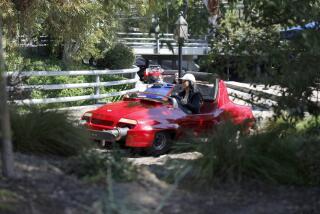A thrilling ride through America’s oldest amusement parks
Reporting from Dorney Park in Allentown, Pa.--
The campgrounds, picnic groves and trolley parks that proliferated in Pennsylvania and Ohio in the late 19th century have survived through lean times and changing tastes to become some of the oldest operating amusement parks in the U.S.
Photos: Vintage rides and attractions at America’s oldest amusement parks
Like many of the oldest theme parks on my trip across America’s Coaster Belt, Dorney Park blends modern amusements with classic attractions.
Among the oldest coasters on our tour is the wooden 1923 Thunderhawk. Twin rows of walnut trees running beneath Thunderhawk mark the location where passengers once arrived at Dorney Park by rail more than a century ago.
Nearby, the 1934 Zephyr train takes riders along the picturesque Cedar Creek, a natural waterway that runs through the park.
The 1920 Whip from Coney Island, N.Y., remains the oldest attraction at the park and my favorite ride at Dorney.
Located at the entrance to the park, the 1921 Dentzel carousel with a Wurlitzer organ and hand-carved giraffes, lions, tigers and deer was moved to Dorney Park from Cedar Point in 1995.
On my trip across America’s Coaster Belt, I’m visiting many of the oldest amusement parks in the country: Cedar Point (1870), Idlewild (1878), Dorney Park (1884), Lakemont Park (1894), Kennywood (1898), Hersheypark (1907) and Knoebels (1926).
Many of the parks were created before the turn of the 20th century as weekend getaways accessible only by wagon, streetcar or steamboat. With the addition of carousels, Ferris wheels, water rides and roller coasters, the summer retreats eventually evolved into the first American amusement parks.
The golden age of amusement parks peaked in the 1920s before a precipitous decline wiped out many of the early parks during the Great Depression of the 1930s and World War II.
A look back at the early days of the 10 oldest operating amusement parks in Pennsylvania and Ohio:
Cedar Point
Cedar Point in Sandusky, Ohio, started in 1870 as a beer garden with guests arriving by steamboat. Its first roller coaster, the Switchback Railway, debuted in 1892. By 1902, the park had added a figure-eight toboggan coaster. A midway with rides, games and fortunetellers soon followed. By the late 1920s, Cedar Point had a shoot-the-chutes water ride, fun houses and a Cyclone coaster.
Idlewild Park
Idlewild Park in Ligonier, Pa., was founded in 1878 as a campground along a railroad line, with fishing, boating, picnicking and dancing. Before the turn of the 20th century, Idlewild had added a steam carousel in the center of the park. Today, the Olde Idlewild area celebrates the park’s traditional amusement rides, including the 1920s merry-go-round, the 1938 wooden Rollo Coaster, the 1939 Whip and the 1947 canopy-covered Caterpillar.
Dorney Park
Dorney Park in Allentown, Pa., traces its history to 1884, when the former trout hatchery was transformed into a summer resort with a scenic railway, Ferris wheel and circle swing. At the turn of the century, the park was purchased by a trolley line, which added a carousel (1901), whip ride (1920) and the “yellow coaster” (1923). The classic Mill Chute dark ride, also known as the Tunnel of Love, opened in 1927.
Coney Island
Coney Island in Cincinnati started in 1886 as a steamboat park as a way to encourage ridership on the ships. During the 1890s, the park added a Giant Circle Swing, a shoot-the-chutes water ride and a wooden Ferris wheel. In the early 1900s, Coney Island added a trio of coasters: Figure Eight, Dip the Dips and Little Dipper. The park upped the coaster ante in the 1920s with the double out-and-back Wildcat and the unique Twister with a track enclosed in a tunnel.
Like many amusement parks during the era, Coney Island took its name from the better-known landmark in New York City.
Conneaut Lake Park
Conneaut Lake Park in Pennsylvania dates to 1892 as a lakefront picnic area. Following a fire in 1908 that destroyed most of the midway, the park built a Scenic Railway roller coaster and a merry-go-round. The 1938 Blue Streak wooden coaster remains the park’s centerpiece.
Lakemont Park
Lakemont Park in Altoona, Pa., opened in 1894 as a trolley park, a precursor to the amusement parks created by streetcar lines as incentives to increase weekend ridership. Lakemont’s most prized possession remains the 1902 Leap-the-Dips, the world’s oldest operating roller coaster. The ride was named a national historic landmark in 1996.
Waldameer Park
Waldameer Park in Erie, Pa., began life as a picnic area until the park was leased by a trolley company in 1896. Over the next couple of decades, the trolley park added three roller coasters: Figure Eight (1902), Scenic Railway (1907) and Ravine Flyer (1922). An Old Mill dark ride soon followed.
Kennywood
Kennywood in West Mifflin, Pa., was transformed in 1898 from “Kenny’s Grove” picnic area into a trolley park with the addition of a carousel, casino and dance hall. Over the next few years, the park added an Old Mill dark ride and a figure-eight toboggan coaster.
During the amusement park boom period of the early 20th century, Kennywood added four roller coasters: Racer (1910), Speed-O-Plane (1911), Jack Rabbit (1920) and Pippin (1924). Three of the coasters remain today: Jack Rabbit, a rebuilt Racer and a renamed Pippin (now Thunderbolt).
In 1995, the park introduced the Lost Kennywood area , which included vintage rides such as the whip, wave swinger and shoot-the-chutes. Kennywood was designated a national historic landmark in 1987.
Hersheypark
Hersheypark in Hershey, Pa., debuted in 1907 as a leisure park for Hershey employees that the chocolate company later opened to the public. Under an entrance sign that proclaimed “Ye who enter here leave dull cares behind,” the park installed a merry-go-round in 1908, a carousel in 1912 and the Wild Cat coaster in 1923. The 1930s saw the addition of a penny arcade, fun house and a Mill Chute log flume ride.
Knoebels
Knoebels in Elysburg, Pa., opened toward the tail end of the golden age of amusement parks but still manages to exemplify that historic era. The one-time swimming hole and picnic grove attracted horse-drawn hayride wagons until Henry Knoebel added a carousel and few games in 1926. Today, the park still recalls an earlier time with classic rides including the Whip, the Looper and hand cars (for both kids and adults).
More to Read
Sign up for The Wild
We’ll help you find the best places to hike, bike and run, as well as the perfect silent spots for meditation and yoga.
You may occasionally receive promotional content from the Los Angeles Times.







